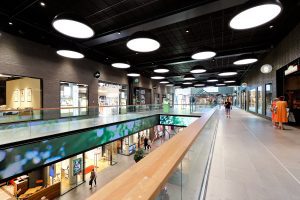Today’s economy has the potential to become sustainable if companies thought of the world as an island in the middle of an ocean of inhospitable space. This island, our earth, provides us fresh air to breathe, fresh water to produce enough food, and provides an abundant amount of energy to distribute food and to build all the necessary materials around us. All resources on a large island can seem abundant, but they will eventually, become constrained.

Sustainability is systemic: either we all succeed together to create a sustainable business ecosystem, or we all will face shortages of critical resources. We must decouple the production of all companies from the amount of energy consumed and the raw materials necessary to manufacture final products.
The understanding of material density is key for improving sustainability. We must reconsider just how much metal, other materials, and energy are necessary to produce goods. The denser our world becomes in the material used for energy and resource production, the more sustainable wealth we will keep. Companies expected to succeed in the 21st century are those that are conscious about the limits of physics on energy and minerals. Further, they will move their core business towards the highest density and resiliency to transform the weakness of scarcity into a business strength. And that strength will precisely come from embracing the circular economy concepts in the core business.
Circular economy: What is and what must be changed?
The concept of a circular economy is very simple: it is about closing all the loops of the linear economy to optimize resources. It is about prolonging product lifespan by refurbishing, repairing, and remanufacturing products to extend their functionality as long as possible, and it is about reusing parts and components in new manufacturing processes. It is also about maximizing business turnover by reselling the same repaired product many times. And ultimately, it is about designing modular and robust products that are easy to dismantle and repair, to enable a new profitable and high-quality second-life business.
What is driving the push to the circular economy now?
We are at a tipping point. Today, we will start facing oil and plastics scarcity, forcing us to recycle more. At the same time, electrification will demand a huge amount of metals to distribute the power to each of the freshly electrified applications. Researchers predict that more metals will be extracted in the next 30 years than during the whole history of humanity. This represents a complicated business environment that attempts to reduce our dependence on fossil fuels and minerals, while at the same time, produce more low-carbon power, heat, and synthetic fuels (hydrogen, ammonia…).
A French study on copper reserves shows that despite metallic mining depletion, one can reach a sustainable copper world supply over the next 100 years, provided we reach 70% of reuse in our supply chains.
Although the timing is unclear, the trend is already there: semi- scarcity will slowly become the rule in the next decade. This does not signal the end of mining, but to reach business sustainability, we will need to dig deeper and deeper, to extract the same amount of metals, requiring more and more energy. At the same time, we also need a huge amount of energy to melt again used metals and to purify them after systematic recycling.
So along with the environmental challenge, going circular is also about becoming less dependent on fossil fuels to generate our energy and plastics and less dependent on new metals for our products. The time has come when companies will look at their business as if was produced on an island. It is time to transform waste into urban mines, essential for future manufacturing.
How circularity can lead to profitability
The “Take-Make-Waste” era is over. The principles of circular profitability are to monetize all products that still have a function, even if slightly altered or downgraded. While few of today’s products have been designed to achieve true circularity, keep in mind the five success factors that can drive circular profitability:
- Create efficient reverse flows and repair centers. To succeed, it is very important to reach critical mass quickly, to provide recurrent business to repair centers, as well as a wide range of high-quality 2nd life offerings for our customers.
- Build circular eco-designs that make dismantling and repairing quick, with scrapping and recycling becoming the very last option.
- Deploy digitization and IoT technologies as enablers for a circular economy. Each product should onboard its circular “digital passport” to assist customers in their preventive maintenance from go-live to end-of-life and provide full traceability of the location of each serial number, the accessories changed, as well as assistance in the process of disposal during the end-of-use. IoT will enable aging calculations based on environmental conditions which are essential to help filter the “goods to be repaired” from the “goods to be recycled.” Eventually, web marketplaces will allow all facility managers to monetize their installed equipment base instead of simply scrapping these items.
- Create an ecosystem of circular partners. In this playing field, cooperation is much more powerful than competition. It is utopian to think companies will manage everything by themselves. Some partners will specialize in collection, some in repairing or reselling, or others can perform recycling as a service. This ecosystem can even be achieved with your competitors to help share the costs.
- Timing must be properly managed from juggling new regulations to effective mineral tensions.
A commitment to business transformation
The majority of businesses have optimized everything for linear logistic operations, which is sometimes called the “Take-Make-Waste” flow. However, those who begin the journey to circularity can expect long-term success. This does imply a deep transformation of all job functions within the company – similar to the changes that have resulted from digitization:
- Marketers will not only focus on new customer needs but will also target the maintenance and repair services opportunity. They will require that end-of-use products be repurposed as materials in the production of new products.
- Engineers will specify circular ready designs that optimize not just the product, but its full lifecycle.
- Supply chain managers will make repair centers and reverse logistics a new competitive advantage.
- Procurement teams will not only look at the costs, but will also take care of the supply of non-virgin materials to secure production sustainability.
- ERP systems will evolve to trace the history of changes made on the repaired products.
- The quality department will create specific circular rules to secure a high level of quality on repaired products, which will be different than the rules for new products.
- The legal departments will look at the new circular regulations, taxes, and customs issues.
- Sales and services will no longer base success on the number of new products sold, but on the number of sales they generate from the same product through its whole lifecycle.
At Schneider Electric we not only want to make the most of our energy, but also make the most of all resources. This commitment was acknowledged this year as the Corporate Knights ranked us the Most Sustainable Corporation in the World. We are conscious that our own business can only flourish if we consider our earth as an island in the middle of Space, where the waste of yesterday will make the gold mines of tomorrow.
Our future products and services will definitively embrace all circular principles: more modular, and easier to repair, upgrade, reuse, and recycle. Cradle to cradle.


